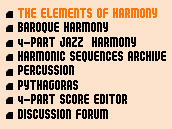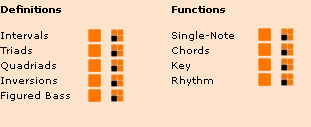




The Tension of Chords
Chords are groups of two or more simultaneously-sounding notes.
In 4-part Harmony, all chords have four notes. Triads generally have three different notes plus one
repeated note, and Quadriads have four different notes.
All 4-note chords, be they Triads or Quadriads, can be built on any of the 7 degrees of the major or
harmonic minor scale, and their position relative to the Key Note, or Tonic, will determine what function
they have within the given Key.
Functions can be Rest-inducing, Mild tension-inducing or High tension-inducing. These 3 functions are
shown in the figure below.
The strongest chords for each function are considered the Primary chords, and are built, respectively,
on the I, IV and V degree of the major or harmonic minor scale. Historically, the Primary chords were
used first, and as Tonal Harmony developed historically, Secondary chords were added. These
Secondary harmonies can be used either to lead to, or substitute for, the Primary harmonies, and each
belong to one of the three function categories.
The positions and functions of all possible Triads and Quadriads in the Key of C major (and C minor,
shown in yellow) are shown in the chart below. Notice that a shorthand notation is adopted to denote
the chords: uppercase and lowercase roman numerals specify whether the 3rd in the triad is major or
minor, while the symbols "o" and "+" indicate how the 5th is altered.
Notice that the harmonies denoted by V, vii![]() and V7 are the same in both keys.
and V7 are the same in both keys.
The Elements of Harmony | Baroque Harmony | 4-Part Jazz Harmony | Harmonic Sequences Archive | Percussion | Pythagoras | 4-Part Score Editor | Discussion Forum